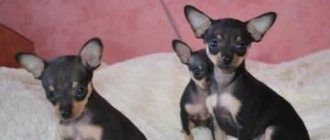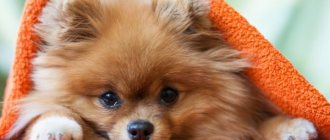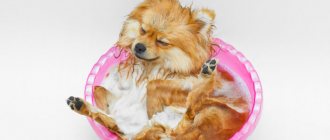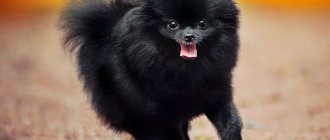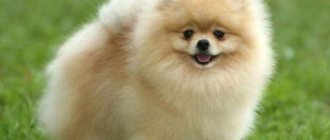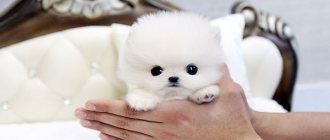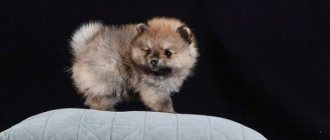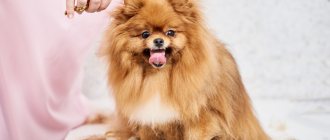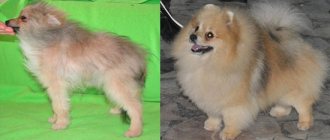A dog's fontanelle is a molera. The fontanel (molera) is a soft area on the head that occurs as a result of non-fusion of the skull bones. Any representative of a decorative breed of dog can have a fontanelle, usually the smallest and thin-boned individuals. Fontanas come in different sizes and shapes, large, with a diameter of half the skull, and small - the size of a pea, round, and also in the shape of a slit, with uneven edges. At exhibitions, it is a disqualifying fault. Puppies can be born with or without fontanelles. Usually by 3 months the fontanel is overgrown, especially if the baby had it very small in size, or in the form of a narrow slit. In some dogs, the fontanel closes only by the age of one year, and in some it does not close at all. If you press your finger against the parietal area of a dog with a molera, you will feel a pulsation and be able to gauge the size of the hole in the skull. Such animals must be handled very carefully, since the brain is covered only by thin skin and there is a high probability of the animal dying from injury. Doctors believe that a large fontanel, a sign of the disease hydrocephalus, when thin bones of the skull and high pressure of the cerebrospinal fluid can lead to cerebral fluid. Read about hydrocephalus here. According to statistics, a very small number of dogs with fontanelles are sick animals. In Diseases of the Brain 1989, Green and Braund stated that many clinically normal toy breeds may have patent fontanelles without associated hydrocephalus. Doctors Walker and Rivers, veterinarians at the University of Minnesota, concluded that the presence or size of a fontanel and the condition of hydrocephalus are in no way related to each other. Dr. Alexander de Lajunta of Cornell University in New York, one of this country's leading neurologists, said calling any open area an abnormality would be misleading. Of course, it is not advisable to breed dogs with molera, but breeders are risky people, and it is no secret that such dogs are bred, especially if the sire is very small, purchased from a well-known kennel, good-looking, and of elite origin. Those. Breeders do not attach much importance to an open fontanel if the dog is healthy. Even if parents do not have fontanelles, their children may have fontanelles. “In my house, puppies with fontanelles were also born, but after 2 months, they were completely overgrown, or significantly decreased and became very tiny. Why is that? I try to feed mommy very well. I definitely add mussel calcium to her diet every day, with vitamin D. I start feeding babies at 3 weeks. Small bitches often have little milk, and babies greedily begin to eat the first complementary food, usually warm boiled milk, then “Tyoma” curd, which they receive every day, then calcined curd, boiled finely pureed beef with rice porridge (I grind rice on coffee grinder until flour), stewed vegetables. Be sure to introduce all products into the menu gradually. I feed the kids often and more, I’m not afraid that they will be large and plump - let them grow, whatever size they are destined to grow in size, that’s what they will become in the end, you can’t fool nature... If the kids eat well and gain weight, they will will not be completely tiny and naturally their fontanelles will begin to quickly overgrow. The trouble is that in decorative breeds, dwarf specimens are highly valued; in most of these puppies, the fontanelles do not heal, and breeders do not want to increase the weight of such puppies. Who in our time will stand at the stove and cook porridge? “Besides, why is it needed, just weight gain....”, it’s better to give a few dog food. I would like to add that when raising babies with not overgrown fontanelles, do not forget to add mineral supplements to the diet, because all puppies need calcium to build the skeletal system. But calcium is very poorly absorbed when there is an excess of protein, i.e. meat, and balance is needed here. As for mineral supplements, I advise you to use American preparations not for breeding. use" or with a note for re-examination at 6 months. Or am I misunderstanding something? Please clarify, I no longer know where to turn and have no experience in such situations.
Answer:
Many breeders do not carefully examine puppies. And these fontanelles may simply not be noticed.
I think that non-closure of the fontanel depends not on the breeder, but on the dog (puppy) itself. And this is very individual.
But if a bitch mates too often, then in her offspring the fontanelle may heal much later or not heal at all.
The defects that are noted in the puppy do not include cleft fontanel.
And one more observation - non-closure of the fontanel often occurs with hydrocephalus. And this must also be kept in mind.
Consults Veterinarian and zoopsychologist Elena Gordeeva - consultations on cats and dogs
The German Spitz and its dwarf variant, the Pomeranian, are one of the most popular toy dog breeds these days. On social networks you can often see photos of Spitz dogs that, after a haircut, look like funny bear cubs.
The Spitz is a wonderful friend, a cheerful companion and a very comfortable pet in all respects. Its light weight and good character allow you to take your pet with you anywhere, because if necessary, it will sit in your arms or in a carrier, and, if necessary, even wear a diaper. At the same time, the Spitz is a vigilant watchman and a good playmate for grown-up children.
Spitz wool requires increased attention from the owner - such beauty should be kept in order. But here grooming salons come to the owner’s aid, which will turn your Spitz into an amazing and unique fashionista, and the owner will only have to regularly brush his pet’s hair.
German Spitz dogs are considered long-livers: on average, their life expectancy is 12-15 years. However, some representatives of this breed live up to 20 years, while maintaining activity and natural energy. Happy is the owner who does not have to deal with serious dog health problems over the years. If your dog does not have congenital diseases, and you take responsibility for its health (deworm and vaccinate it on time, feed your dog properly, etc.), you will have a long, happy life together.
Choosing a Spitz
Paying tribute to fashion, most potential owners strive to get a dog as small as possible. Therefore, preference is often given to the Pomeranian Spitz over its larger brother, the German Spitz. Like all very small dogs, Pomeranians, more than their medium-sized counterparts, need high-quality regular feeding and increased attention to their health.
And it, this very health, strongly depends on variations in the size of the dog, even within the breed.
It is more difficult for a very small dog to organize food, since what we consider as a “small piece” for such a dog is like a couple of hamburgers for a losing weight lady.
Dwarfism in Pomeranian Spitz dogs is achieved in two ways: honest breeders choose, as a rule, the smallest males and breed them with medium-sized females so that the puppy receives everything he needs. And dishonest breeders do not disdain matings between two “dwarfs” or with other dogs of the toy group, in particular, with Chihuahuas. Hence – bulging eyes, a “hydrocephalic” head, and non-closure of the fontanel.
In addition, the smaller the dog, the thinner its bones, the more problems you can get with your long-awaited pet. The reason is that there is a very clear relationship between the innate qualities of the musculoskeletal system and the clinical manifestations of many diseases inherent in dwarf dogs in general and Spitz dogs in particular.
A number of neurological diseases are associated with the quality of the articulation of the skull and the first cervical vertebrae, and this directly depends on the congenital characteristics of bone development. Therefore, we strongly advise you not to choose a very small dog at an early age (2-3 months).
So, you should not choose a dog earlier than 3 months of age, thin-boned, very small, with an open fontanel, a clearly defined voluminous forehead and too bulging eyes. Beware of choosing puppies that are too "quivering", gentle or sedentary, as well as puppies with "strange" behavior.
We strongly advise you to opt for a Pomeranian Spitz at least 3 months old, not the smallest in size, with strong bones, not too bulging eyes, overgrown fontanel, active and outwardly healthy.
Despite its small size, the Spitz is a full-fledged dog. He needs more than just food and a diaper for the toilet. Walks and communication with the owner are very important for a Spitz.
It is not enough for a Spitz to simply exist within the master’s four walls. Sunlight, new experiences and active movement in a new space are very important to him. This dog enjoys active interaction with its owner, such as learning tricks, or agility, or active games in nature. Therefore, do not be lazy to walk your Spitz as often and as long as possible.
From childhood, try to accustom your little Spitz to communicate with his own kind. Don’t be afraid that someone will hurt your baby, just choose his playmates wisely.
Remember that the Spitz very sensitively senses the state of its owner (and especially the mistress), so it is very important in what environment your furry baby is kept. An unstable owner's state of mind, sudden mood swings, unpredictable reactions to the dog's behavior - all this can have a detrimental effect on the dog's health - against this background, the pet can develop gastritis, cholecystitis and pancreatitis, which are very difficult to treat.
Active movement, mental games and a stable, predictable owner are the key to good health and long life for a Spitz.
Feed your Spitz at least 3 times a day, at the same time. Remember that small dogs can suffer from hypoglycemia, so when stressed, do not forget to feed your pet, and in extreme cases, give him some sweet water.
Which diet to choose for a pet—natural food or industrial food—each owner decides for himself based on a number of criteria. The most important thing to remember is that the Spitz should receive a stable, balanced diet every day with a mandatory load on the jaws. That is, if the main food is soft, then hard “chews” are required. And if the dog eats dry food, then the share of such treats can be reduced.
Spitz development
On average, the weight of a Spitz puppy at birth ranges from 70 to 170 grams. In large-sized bitches (small, 25-29 cm tall), puppies usually weigh more than 100 g. But sometimes puppies are born weighing less than 70 g, especially in dwarf and light-boned dogs, as well as in small dogs whose pedigrees include dwarf Spitz dogs.
It happens that at first a puppy develops normally, but then its growth can be severely retarded. This is due to congenital deficiency of growth hormone and other hormones of the hypothalamus and pituitary gland. It is these hormones that are “responsible” for the development and health of the entire body. Such puppies often have large fontanelles. Adult Spitz dogs less than 18 cm tall (especially females) are highly undesirable. These dogs have too thin bones, bulging eyes, and an open fontanel. Such a dog may also have a very problematic nervous system.
All pronounced signs of dwarfism make the dog unsuitable for breeding and exhibitions.
Even if the owner does not pursue the goal of breeding, then even as a pet/companion, a dwarf dog will require too much attention from the owner: health problems associated with dwarfism will become an integral part of your life together. Therefore, when purchasing a very small puppy, you risk being “registered” by the veterinarian.
Spitz diseases
Dental diseases
Pomeranians often have dental problems. As your pet ages, one problem replaces another.
Nerves during the period of teeth change await many owners of a dwarf dog. The Pomeranian's baby teeth have very long roots, which, due to hormonal conditions, are very poorly absorbed. Being deep in the gums, they interfere with the natural loss of baby teeth. Because of this, the loss of baby teeth is delayed
. As a result, problems arise with the development of molars and proper bite.
When an owner strokes a Chihuahua puppy's head, he or she feels a soft opening in the upper area of the animal's skull. There is no reason to panic. According to statistics, 70-80% of puppies are born with a similar anatomical feature.
The soft spot in the area of the dog's skull is scientifically called - Malera molera
.
Among breeders and hobbyists, the most common common name is fontanel
. For a long time, the fontanel in Chihuahuas was considered a sign of the purebred of the breed.
After the discovery of molera in a Chihuahua, the owners of the breed are concerned about some questions. In the article we will consider in detail the breed's anatomical features and answer the following questions:
- How common is molera in Chihuahuas?
- at what age does it overgrow;
- Is it related to the development of hydrocephalus?
- how to care for a puppy or adult with an open (not overgrown) fontanel;
- Is molera a breed disqualifying fault according to international breed standards?
What is a fontanelle and what is its function?
First, let's figure out what a fontanel is and what its function is. During the birth process, the puppy experiences strong contraction pressure from the walls of the uterus and as it moves through the birth canal. To make life easier for yourself and your mother, the puppy needs to leave the birth canal as quickly as possible.
The largest part of a puppy's body is its head. The babies' heads literally shrink during the expulsion process, and this is only possible thanks to a cleft in the skull. By the way, a cleft in the skull is called differently depending on the age of the dog:
- Puppies have a fontanel. A natural crevice that is overgrown.
- In adult dogs - molera. A soft spot on the dog’s skull, which is formed as a result of non-union of the cleft or its re-formation.
A puppy’s fontanel is a “weak” place, so babies need to be handled very carefully. A headbutt or excessive compression can cost the puppy his life until the cleft in the skull closes.
Shih Tzu of Ukraine, breed forum
Small bitches often have little milk, and babies greedily begin to eat the first complementary food, usually warm boiled milk, then “Tyoma” curd, which they receive every day, then calcined curd, boiled finely pureed beef with rice porridge (I grind rice on coffee grinder until flour), stewed vegetables. Be sure to introduce all products into the menu gradually. I feed the babies often and more, I’m not afraid that they will be large and plump - let them grow, whatever size they are destined to grow in size, that’s what they will become in the end, you can’t fool nature. If the babies eat well and gain weight, they will not be completely tiny and naturally their fontanelles will quickly begin to overgrow. The trouble is that dwarf specimens are highly valued in decorative breeds; in most of these puppies, the fontanelles do not heal, and breeders do not want to increase the weight of such puppies. Who in our time will stand at the stove and cook porridge? “Besides, why is it needed, just weight gain....”, it’s better to give a few dog food.
At what age does the fontanel usually overgrow?
Many owners are interested in the age at which the fontanel usually heals and at what age the cleft is considered a defect. By generally accepted standards, the fontanelle can close before 3 months of age.
Note! The smaller the dog, the longer the cleft in the skull (fontanelle) takes to close.
Molera is considered relatively normal in some breeds:
- Brachycephals of all sizes, especially common in English Bulldogs and Pugs.
- Chihuahua.
- Dwarf dachshund.
- Pomeranian Spitz.
- Shih Tzu.
- Yorkshire Terrier.
- Maltese.
- Lhasa Apso.
- Boston Terrier.
- Cairn Terrier.
- Pekingese.
- Toy poodle.
For all other dogs, an unclosed cleft is a potential problem.
What is the danger of an unovergrown fontanel in a dog?
Some dogs with molera live full lives, only occasionally suffering from headaches. The main “symptom” of an open fontanel is a soft spot or hole in the skull that remains in an adult dog. The main threat is that a minor injury can become fatal.
What is dangerous about an unovergrown fontanel in a dog? It is believed that it is this defect that causes the development of acquired (noncongenital) hydrocephalus. Early symptoms of the disease are:
- Inability to control gaze.
- Protrusion of the eyeballs.
- Headache attacks. The dog hides in a dark place, flinches from sounds, looks apathetic, turns not its head, but part of its body.
- Meteor dependence.
- Head tilt.
- Poor skill acquisition.
- Stunted growth.
- Hyper-reactivity.
- The dog may wander aimlessly around the house for a long time or walk in circles.
- Problems with coordination and orientation in space.
- Blindness.
- Convulsive attacks.
Naturally, the most serious threat with the symptomatic “expression” of hydrocephalus is convulsive seizures. The seizure itself can kill a dog if it doesn't get help. In addition, during convulsions, the dog hits its head, resulting in the formation of hematomas directly in the brain.
Diseases of Pomeranian Spitz
Usually, diseases in Pomeranians stem from the miniature size of the animals. After all, dogs of this breed were created using artificial methods, thanks to the painstaking work of breeders. In addition to problems at the genetic level, no dog is immune from various infections and parasites. What diseases can appear in a dwarf Pomeranian, as well as what to do in case of a particular disease, read in this article.
Main problems
If you decide to get a Pomeranian or already own one, you should be aware of the disadvantages of this dwarf breed, such as possible diseases. After all, taking care of a dog’s physical health is the basis of its longevity. Timely detection of symptoms and the necessary preventive actions can save the Pomeranian's life.
Timely vaccinations and deworming can prevent diseases such as distemper, hepatitis, leptospirosis, gastroenteritis, coronavirus, and adenovirus.
But this does not mean that after routine vaccinations, you can forget about diseases. You will have to periodically monitor your purebred dog so as not to miss the first symptoms of the disease. Lack of attention on your part and, as a result, late help can lead to serious and sometimes chronic illness.
Anatomical properties
Pomeranians often have dental complications. Problems during the period of teeth change await many owners of a dwarf dog. The Pomeranian's first teeth have very long roots. Being deep in the gums, they interfere with the natural loss of the first teeth. As a result, problems arise with the development of molars and proper bite.
To avoid such violations, you need to periodically examine your dog's teeth. If you notice that baby teeth are inhibiting the development of primary teeth, contact them immediately.
Medicines and methods to maintain health
While a puppy's fontanel can and most likely will close, such a problem in an adult dog is almost always irreversible.
It is especially difficult for owners of dogs that suffer from “related” diseases, for example, hydrocephalus. In this case, it is the concomitant disease that is treated, since an open fontanelle in itself does not threaten the dog’s life.
Medications to eliminate hydrocephalus:
- When diagnosed early, hydrocephalus is treated with medications. The main goal is to relieve inflammatory processes in the brain.
- In the acute stage of the disease, anticonvulsants, diuretics (to reduce fluid production) and electrolytes are added to therapy.
Unfortunately, all drug solutions are temporary; the only way to prevent the development of hydrocephalus is a shunt, which is installed surgically.
A shunt is a small tube that is implanted into a ventricle of the brain to safely “drain” excess cerebrospinal fluid. Such operations are rarely performed on puppies, since as they grow, the shunt will have to be removed and replaced. Note that neither treatment nor drainage has any effect on a cleft in the skull, but with normal intracranial pressure, the dog can live a full life.
Obesity
Pomeranians love to eat a lot and often.
. They are especially greedy for human food - be it a piece of pizza or a chocolate bar. A begged-for supplement and a couple of “snacks” between breakfast and lunch lead to the fact that the Pomeranians turn into loose fat globules within a month.
A pet with excess weight on the sides is doomed
to broken bones and deformed joints, since Pomeranians cannot boast of strong paws.
In addition, obesity leads to gastrointestinal and metabolic diseases
, which are much more difficult to cure.
Symptoms
: overweight, low mobility.
Treatment
: diet, physical activity.
Fontana and hydrocephalus - is there a connection?
Fontana and hydrocephalus - is there a connection? There is no definite answer! In many cases, open fontanelles in dogs are the cause of hydrocephalus, or an abnormal buildup of cerebrospinal fluid. Many experts believe that there is an inverse relationship - increased intracranial pressure prevents the fontanel from closing or leads to the appearance of a crack.
Hydrocephalus can be acquired or genetic. In many cases, this condition causes death. At the same time, many dogs live with an open fontanelle and do not suffer from hydrocephalus.
How common is molera in Chihuahuas?
Approximately eight out of ten puppies are born with an open spring on the skull. A common anatomical feature is mentioned in the standards of the Chihuahua breed by international canine associations. An open fontanel in an adult is recognized as a disqualifying defect of the breed and is not allowed to participate in breed exhibitions. It's a paradox, isn't it?
In the early years of the breed's existence, Chihuahua puppies born with an open fontanel were common.
In the mid-1970s, miniature members of the breed were developed with a preferred weight of only 1.5 to 3.5 kg. The number of dogs with open molera is decreasing as a result of changes in breeding practices among professional breeders.
Rules for keeping a dog with an open fontanelle
Quite often, an open fontanel becomes a fact that the owner has to come to terms with. The owner must understand the seriousness of the responsibility and ensure that the dog does not suffer a head injury.
Note! Dogs with molera are advised to live in a home without other animals or children.
Rules for keeping a dog with an open fontanel:
- Walk separately from other dogs or wear a helmet.
- Avoiding exercises that require a lot of effort or dexterity to perform.
- Exclusion from breeding! Molera is a hereditary problem.
- Visit the veterinarian at least once every 3 months.
If a dog develops hydrocephalus, even with high-quality and timely treatment, recovery may not occur. Hydrocephalus is a sneaky sore, it always comes back, and each relapse can be treated from 2 months to 2 years.
Shih Tzu of Ukraine, breed forum. Shih Tzu puppies, show results...
The fontanel in a dog is a molera. The fontanel (molera) is a soft area on the head that occurs as a result of non-fusion of the bones of the skull. Any representative of a decorative breed of dog can have a fontanelle, usually the smallest and thin-boned individuals. Fontanas come in different sizes and shapes, large, with a diameter of half the skull, and small - the size of a pea, round, and also in the shape of a slit, with uneven edges. At exhibitions, it is a disqualifying fault.
Puppies can be born with or without fontanelles. Usually by 3 months the fontanel is overgrown, especially if the baby had it very small in size, or in the form of a narrow slit. In some dogs, the fontanel closes only by the age of one year, and in some it does not close at all. If you press your finger against the parietal area of a dog with a molera, you will feel a pulsation and be able to gauge the size of the hole in the skull. Such animals must be handled very carefully, since the brain is covered only by thin skin and there is a high probability of the animal dying from injury. Doctors believe that a large fontanel, a sign of the disease hydrocephalus, when thin bones of the skull and high pressure of the cerebrospinal fluid can lead to cerebral fluid. Read about hydrocephalus here. According to statistics, a very small number of dogs with fontanelles are sick animals. In Diseases of the Brain 1989, Green and Braund stated that many clinically normal toy breeds may have patent fontanelles without associated hydrocephalus. Doctors Walker and Rivers, veterinarians at the University of Minnesota, concluded that the presence or size of a fontanel and the condition of hydrocephalus are in no way related to each other. Dr. Alexander de Lajunta of Cornell University in New York, one of this country's leading neurologists, said calling any open area an abnormality would be misleading. Of course, it is not advisable to breed dogs with molera, but breeders are risky people, and it is no secret that such dogs are bred, especially if the sire is very small, purchased from a well-known kennel, good-looking, and of elite origin. Those. Breeders do not attach much importance to an open fontanelle if the dog is healthy. Even if parents do not have fontanelles, their children may have fontanelles. In my house, puppies with fontanelles were also born, but after 2 months, they were completely overgrown, or significantly decreased and became very tiny. Why is that? I try to feed mommy very well. I definitely add mussel calcium to her diet every day, with vitamin D. I start feeding babies at 3 weeks. Small bitches often have little milk, and babies greedily begin to eat the first complementary food, usually warm boiled milk, then “Tyoma” curd, which they receive every day, then calcined curd, boiled finely pureed beef with rice porridge (I grind rice on coffee grinder until flour), stewed vegetables. Be sure to introduce all products into the menu gradually. I feed the kids often and more, I’m not afraid that they will be large and plump - let them grow, whatever size they are destined to grow in size, that’s what they will become in the end, you can’t fool nature... If the kids eat well and gain weight, they will will not be completely tiny and naturally their fontanelles will begin to quickly overgrow. The trouble is that dwarf specimens are highly valued in decorative breeds; in most of these puppies, the fontanelles do not heal, and breeders do not want to increase the weight of such puppies. Who in our time will stand at the stove and cook porridge? “Besides, why is it needed, just weight gain....”, it’s better to give a few dog food. I would like to add that when raising babies with not overgrown fontanelles, do not forget to add mineral supplements to the diet, because all puppies need calcium to build the skeletal system. But calcium is very poorly absorbed when there is an excess of protein, i.e. meat, and balance is needed here. As for mineral supplements, I advise you to use 8 in 1 preparations from an American company. CALCIDEE Calcium, phosphorus and vitamin D tablets with a pleasant taste and smell of milk contain calcium, phosphorus and vitamin D in the optimal ratio for the proper development of bones and teeth in puppies and kittens. They are simply necessary for pregnant and lactating bitches and cats. A drug of this composition is compatible with any balanced feed and other multivitamin supplements. Application: Give the tablets whole or crush them into food. For small dogs, cats, kittens: 1/2 - 1 tablet per day Ingredients: Dicalcium phosphate, whey powder, stearic acid, silicate, magnesium stearate, cholecalciferol, vanillin. To quickly heal the fontanel, puppies are prescribed Osteogenon. And in conclusion: dwarf breeds are the smallest representatives of the dog family, and they should be treated especially tenderly, regardless of whether they have a fontanel or not. They are not created to herd livestock, catch criminals, fight wolves, they live for our joy and give us love and affection. Let your charges make you happy and be healthy!
>Spitz's fontanel when the fontanel overgrows

